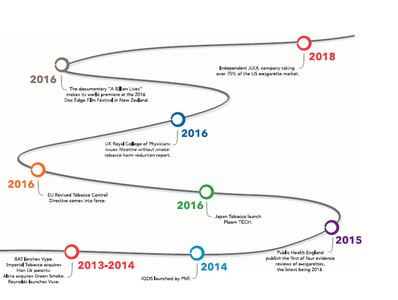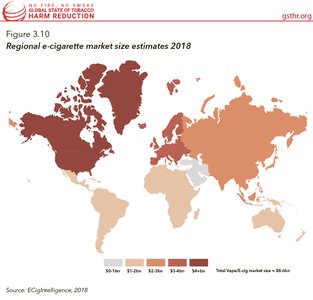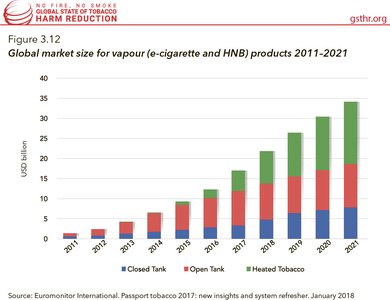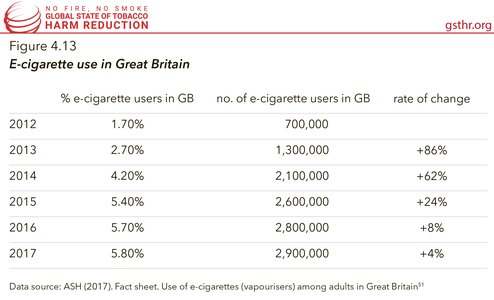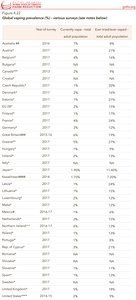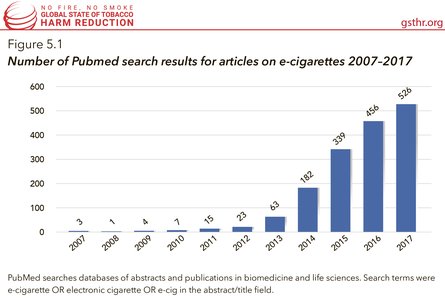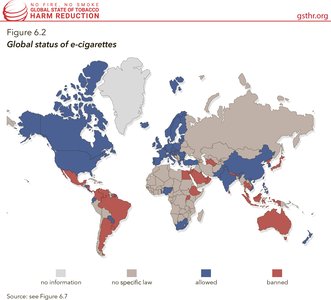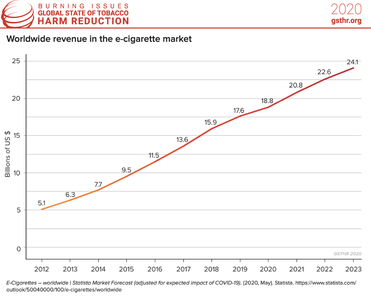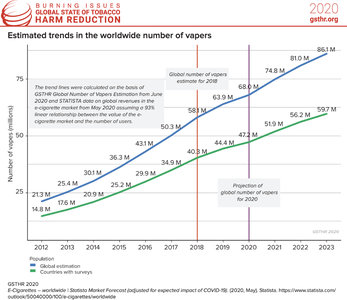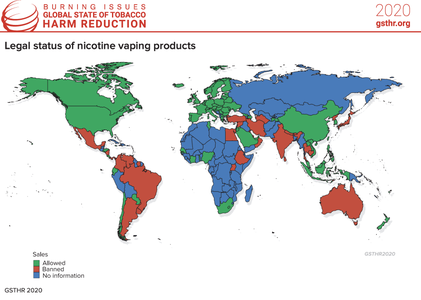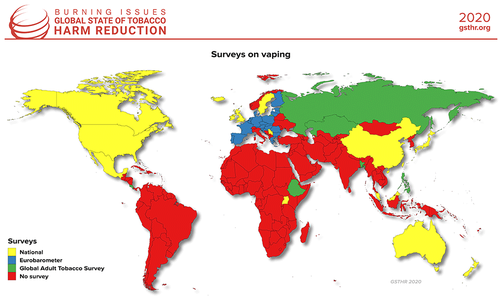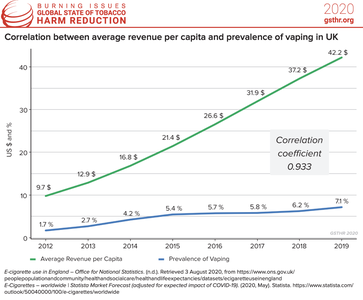Vaping
Vaping Timeline, 1927 to 2018
- No Fire, No Smoke: The Global State of Tobacco Harm Reduction
Regional E-Cigarette Market Size Estimates (2016)
- No Fire, No Smoke: The Global State of Tobacco Harm Reduction
North America is by far the largest e-cigarette market, followed by Western Europe, Eastern Europe, Asia Pacific, and then the rest of the world. The market share for different products varies in different countries. For example, possibly due to their relatively low cost, cigalikes enjoy a 50% share in a very small market like Azerbaijan, followed by 43% in Austria, 42% in the USA, 39% in China, and 38% in Ecuador. The USA accounts for 70% of the US$500m global market for the relatively new pod mod systems (a system similar to using coffee pods like Nespresso), with only the UK, Italy, Poland, and France having a market share greater than 9%.
In the more mature e-cigarette markets, open systems are still dominant, the top five markets being USA, UK, Italy, Germany and France, followed by China, Russia, Poland, Canada and Malaysia. But, according to Euromonitor analysis, open systems do face future challenges. The analysis speculates that the ability to customise devices is likely to appeal to early adopters, who are frustrated by the inflexibility of cigalikes, which once offered the only safer option. Those early adopters are likely to continue populating the niche market in ultra-flexible devices. However, new products might appeal more to newer consumers who do not want basic cigalikes, but are not interested in customising devices. For those consumers, closed system products are likely to be more attractive, offering both convenience and choice. But it would be wrong to assume that those using safer nicotine products stick to one type of product. Some consumers will use a range of different e-cigarettes, heat-not-burn products and snus to suit both their mood and the environment they find themselves in.
See also p. 31 of the report: No Fire, No Smoke: The Global State of Tobacco Harm Reduction 2018 — Global State of Tobacco Harm Reduction (gsthr.org)
Global Market Size for Vapour (E-Cigarette and HNB) Products (2011-2021)
- No Fire, No Smoke: The Global State of Tobacco Harm Reduction
As with any economic forecasting, market analysts will have differing views as to the future state of commodity markets. This is particularly evident when making predictions about safer nicotine products, especially with uncertainties about global regulations. This graphic shows estimates from Euromonitor showing the continuing growth of the combined e-cigarette and heat-not-burn markets.
In 2012, the global market value for e-cigarettes was estimated by Euromonitor at US$2bn. In 2018, their estimate for the global market was around US$14bn (higher than the E Cig Intelligence estimate of US$8.6bn).
Euromonitor now combines estimates for e-cigarettes and heat-not-burn into a single ‘vapour product category’. In 2016, the figure for all vapour products had jumped to around US$12.3bn.
At the moment, this puts vapour products behind all forms of tobacco products – not just cigarettes at US$683.4bn, but also smoking tobacco (US$26.8bn), cigars (US$25.8bn) and smokeless tobacco (US$12.5bn). Though still small in comparison with the cigarette market, the growth rates are significant: Euromonitor reports growth in vapour products sales value of 818% over the period 2011 to 2016.
But by 2021 Euromonitor estimates, the all-product vapour market will be more valuable than the market for all tobacco products except cigarettes, with a global value of around US$34bn.
There was a 43% growth in the value of the global market in 2015, but this had slowed to 34% in 2016. Analysts attribute this slowdown to the fact that in the strongest markets, like the USA, consumers were moving away from market leader cigalikes (as found in many service stations and convenience stores) towards more closed system products or pod mods, which combine the convenience of cigalikes with the greater flavour ranges and nicotine strengths offered by self-fill systems.
See also p. 35 of the report: No Fire, No Smoke: The Global State of Tobacco Harm Reduction 2018 — Global State of Tobacco Harm Reduction (gsthr.org)
E-Cigarette Use in Great Britain
- No Fire, No Smoke: The Global State of Tobacco Harm Reduction
The anti-smoking charity ASH has conducted repeat surveys on the use of e-cigarettes in the adult population in Great Britain (England, Wales, and Scotland) since 2012. Sample sizes are substantial at around 12,000 adults (18 and over) each year. These surveys show a steady increase in the proportion of the adult population who use e-cigarettes, up from just under two percent in 2012 to nearly six percent in 2017. There appears to be some slowing of the increase in 2016 and 2017.
ASH, working with King’s College London, has estimated the prevalence of e-cigarette usage in Great Britain by using the findings of the surveys and applying these to the most recent population data available in each year. This shows that in 2017:
» An estimated 2.9 million adults in Great Britain were currently using e-cigarettes;
» Of the 2.9 million current e-cigarette users, approximately 1.5 million (52%) were ex-smokers.
See also p. 51 of the report: No Fire, No Smoke: The Global State of Tobacco Harm Reduction 2018 — Global State of Tobacco Harm Reduction (gsthr.org)
Global Vaping Prevalence (%) - Various Surveys
- No Fire, No Smoke: The Global State of Tobacco Harm Reduction
For the first time we have tried to bring together the extant information on the prevalence of use of e-cigarettes, and this is summarised in this graphic using data for 2017 gathered from Eurobarometer. This information is also available online, on a country-by-country basis where it exists, at https://gsthr.org/countries/.
Overall, as a percentage of the total adult population, levels of current use of e-cigarettes in different countries range between 1% and 6%. Levels of sometime experience with e-cigarettes range up to 27% of the adult population in Greece, and 20% or above in Estonia, Czech Republic, France, Cyprus, Latvia, and Austria. Clearly there are many smokers who are interested in these products. But there is also a large gap between those who have shown enough interest to have tried an e-cigarette at some time, and those who have gone on to currently use them. The highest prevalence of vaping is found in Great Britain where approximately 6% of the adult population currently vapes. There are limitations with all surveys on vaping, but one of the most extensive datasets is from Eurobarometer 458. The European Commission used this public opinion gathering resource to conduct an extensive survey of e-cigarette use across the EU as part of a wider review of smoking habits.
The key findings were that across the 28 countries of the EU in 2017:
» Around 15% of those aged 15 or over had tried an e-cigarette at least once – compared to 12% in 2014;
» 2% of the population are current users and this has remained stable since 2014;
» Almost one in twenty current smokers now currently use e-cigarettes or similar devices (four percent), and 4% of ex-smokers;
» Current use of e-cigarettes among people who have never smoked is rare. At most, one percent of e-cigarette users in any EU country are people who have never smoked.
We have tried to gather information on current or daily use, as well as on the numbers who have ever used e-cigarettes. However, there are large gaps – we have only been able to obtain recent, reliable data from 36 countries, and much of this information comes from one major EU survey. Clearly global interest in e-cigarettes by consumers and some policy makers has not been matched by government or academic surveys to explore even the extent of use. Readers must be aware of limits to the comparability of the sources. Surveys can suffer from numerous differences, due to variations in sampling methods and questions asked. We therefore suggest caution in making country comparisons.
See also p.40 and p.58 of the report: No Fire, No Smoke: The Global State of Tobacco Harm Reduction 2018 — Global State of Tobacco Harm Reduction (gsthr.org)
Number of PubMed Search Results for Articles on E-Cigarettes 2007-2017
- No Fire, No Smoke: The Global State of Tobacco Harm Reduction
There has been a major increase in the number of publications on e-cigarettes. Our search for articles on them shows the increasing interest in the subject over the last ten years. From 2007-12, there were only 53 publications recorded. Between 2013 and 2017, the figure jumped to over 1500.
But more science does not always mean better science or better science communication. Poorly formulated and designed research, over-cooked announcements of research results, over-hyped university press releases and an uncritical media with an appetite for bad news stories all create a perfect storm of confusion among the general public, smokers and users of safer nicotine products (SNP) as to the advisability of switching away from smoking to SNP.
The advent of SNP left the global public health community itself divided. Many working in tobacco control regard SNP as a ruse by tobacco companies to renormalise smoking, especially in countries where adult smoking rates have been in decline for decades – and citing in particular a fear of young people being led through a ‘gateway’ to regular smoking. Others – public health officials, academics, clinicians and consumer advocates among them – point to evidence that SNP are significantly less harmful than smoking cigarettes for those who cannot or do not want to give up nicotine, those who want to cut back on smoking, or quit altogether. From this follows the conclusion that a switch to SNP has the potential to save many lives and moreover, at no cost to governments or taxpayers.
See also p. 60 of the report: No Fire, No Smoke: The Global State of Tobacco Harm Reduction 2018 — Global State of Tobacco Harm Reduction (gsthr.org)
Global Status of E-Cigarettes
- No Fire, No Smoke: The Global State of Tobacco Harm Reduction
At the time of writing most countries do not have any specific law regulation regarding e-cigarettes: 101 countries have no specific law on e-cigarettes. It is possible that if it came to a government or court decision, it might be that in some of these countries e-cigarettes would be found to be covered by tobacco control legislation. However, this has yet to be determined in many countries. This includes many LMIC, where it is likely that e-cigarettes are not yet available or are only used by a minority.
At the other end of the spectrum there are 39 countries where the sale of e-cigarettes or nicotine liquids is banned. It is worth noting that rather like the failure of bans on recreational drugs to be effective, e-cigarettes are known to be available in at least 14 of these 39 countries. For example, e-cigarettes and nicotine are widely available and used in Australia. Some of the banning countries had pre-existing laws in which e-cigarettes and nicotine liquids were caught up – as again for example in Australia where the poisons regulations under the jurisdiction of the Therapeutic Goods Administration (TGA) prohibit the unauthorised sale, possession and use of nicotine.
Several countries have a legal and regulatory framework for e-cigarettes, and this is generally a mix of a legal framework – often within the context of tobacco control legislation (as in the USA and Europe), plus product standards and legal or voluntary control over access to the products by young people. The most usual legislative route is to regard them as tobacco products, and/or as consumer products.
In most jurisdictions manufacturers are only allowed to promote e-cigarettes as safer than cigarettes and as aids to quitting if they are registered as medicinal products, similar to the regulations governing nicotine replacement therapies. In ten countries there is provision for medically regulated products.
See also p. 84 of the report: No Fire, No Smoke: The Global State of Tobacco Harm Reduction 2018 — Global State of Tobacco Harm Reduction (gsthr.org)
Worldwide Revenue in the E-Cigarette Market
- Burning Issues: The Global State of Tobacco Harm Reduction 2020
The US is the world’s biggest vaping market. Vaping products account for somewhere between 5-10 percent of the tobacco market (excluding sales from smaller outlets noted above) and for about 70 per cent of the global market in new pod mod systems.
The share of the vaping market owned by tobacco companies remains small. Tobacco companies are estimated to have less than 20 percent market share of the global vaping market. In France, Italy, Germany and most other markets it is less than 10 per cent; in the USA and Russia it is around 20 percent, and estimated to be highest in the UK (33 percent) and Poland at around 50 percent. In China, it is zero percent. Japan dominates the market in heated tobacco products with smaller but growing markets in over 50 other countries.
In the light of a more adversarial atmosphere in the US towards vaping products and eager not to endure a Kodak moment, all the major tobacco companies have now brought non-tobacco nicotine products to market.
Most market estimates predict continued growth but there are concerns about the impact of misinformation about teen vaping, scares about vaping-related lung injury and deaths, COVID-19 and the increasingly belligerent attitude towards safer nicotine products among legislators.
See also p.46 of the report: Burning Issues: The Global State of Tobacco Harm Reduction 2020
Estimated Trends in the Worldwide Number of Vapers
- Burning Issues: The Global State of Tobacco Harm Reduction 2020
We estimate that in 2020 there were approximately 68 million nicotine vaping product users worldwide. However, this estimate should be treated with caution, as there is great uncertainty about some of the individual country estimates, and for 152 countries and territories data were missing. There is also variation in survey definitions of vaping. It is obvious from the data collected and assessed in our database that the available information is often of poor quality – survey samples are not numerous enough to provide sufficient precision to measure such small parts of the population. The sampling method of many studies is not probabilistic, which makes it impossible to generalise the measured values correctly per population. It is well known that monitoring risk behaviours in hidden populations is not straightforward. However, efforts to improve the accuracy of the information systems should be encouraged.
As of 2021, the estimated global number of nicotine vaping product users has increased to 82 million. For our analysis of these latest data see p.62 of the report: The Global State of Tobacco Harm Reduction 2022: The Right Side of History
See also p.157 of the report for further analysis of the 2020 data: Burning Issues: The Global State of Tobacco Harm Reduction 2020
Legal Status of Nicotine Vaping Products
- Burning Issues: The Global State of Tobacco Harm Reduction 2020
Beyond the big picture there is a whole panoply of regulatory options covering product registration, safety and limitations (such as nicotine content, and flavour bans), taxation levels, online sales, age-purchase limitations and public space vaping. For country specific detail, see the GSTHR website.
» 64 countries have age restrictions on the sale of nicotine vaping products.
» 71 countries regulate the advertising of e-cigarettes (34 of these countries allow at advertising at point of sale, 59 do not allow advertising in mass media and 26 have a complete ban on all advertising).
» 30 countries tax vaping liquid.
See also p.121 of the report: Burning Issues: The Global State of Tobacco Harm Reduction 2020
Surveys on Vaping
- Burning Issues: The Global State of Tobacco Harm Reduction 2020
Estimates of the prevalence of vaping are critical to measuring the uptake and coverage of THR. However, information on the prevalence of vaping is still scarce in many countries. WHO promotes the MPOWER tobacco control programme, the first letter of which refers to Monitoring. One of the key points of this is to collect up-to-date information on issues related to the use of tobacco and related products. Unfortunately, in reality this is a very difficult task for many countries due to costs. Collecting information about the value of a particular characteristic in a given population requires a representative survey based on a random sample. Such surveys are expensive. Market data are available within companies and from market research and analysis companies such as EuroMonitor. However there is an unclear relationship between market size – by value or units sold – and the prevalence of vaping in the population.
We have found information on the prevalence of vaping from 49 countries. There are two publicly-available international research programmes and eight national programmes on tobacco use and vaping.
The international research from which we collect data is: The Global Adult Tobacco Survey (GATS), last conducted in 2017, providing data on six countries (there are 25 of them in the study, but we used only six due to outdated surveys or not covering the subject of e-cigarettes); and the Special Eurobarometer on Attitudes of Europeans towards tobacco and electronic cigarettes from the European Commission, last conducted in 2017, gathering data from 28 countries.
There are also International Tobacco Control Surveys in 29 countries with data on e-cigarettes in six countries but we did not use it due to methodological issues (ie use of non-probabilistic samples).
National surveys on tobacco use and vaping (or at least having some information on
this topic) include for example:
» National Drug Strategy Household Survey 2019 (Australia).
» Healthy Ireland Survey 2017.
» Malaysia 2016 National E-Cigarette Survey.
» Encuesta Nacional de Consumo de Drogas, Alcohol y Tabaco (ENCODAT 2016-2017, Mexico).
» Use of e-cigarettes among adults in Great Britain, 2019 (ASH UK).
» Surveys from the Office for National Statistics (UK 2019).
» National Adult Tobacco Survey (US).
In addition, we have information from general surveys for seven other countries.
Data were introduced in our database and maintained by the GSTHR research group. Quality controls – consisting of the continuous cooperation with regional informants around the world – are regularly performed to ensure that sources are updated, and data are introduced correctly.
See also p.151 of the report: Burning Issues: The Global State of Tobacco Harm Reduction 2020
Correlation Between Average Revenue Per Capita and Prevalence of Vaping in UK
- Burning Issues: The Global State of Tobacco Harm Reduction 2020
Given the time lapse between when surveys were undertaken and 2020, it is necessary to estimate subsequent growth. The question is, what is the relationship between market growth and changes in vaping prevalence? We have information on this for the UK for the period 2011 to 2019. We have used market revenues per capita to avoid distortions related to population changes. As we can see in this infographic, both trends were characterised by steady growth. The correlation between both time series was very strong. On the basis of this analysis, it can be concluded that the changes in the revenues from the vape market have influenced the prevalence of vaping products with 93% efficiency. Then we assumed that this relationship is similar globally.
See also p.155 of the report: Burning Issues: The Global State of Tobacco Harm Reduction 2020
